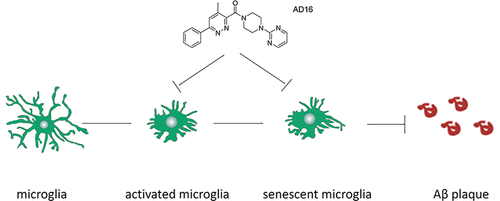当前位置:
X-MOL 学术
›
ACS Pharmacol. Transl. Sci.
›
论文详情
Our official English website, www.x-mol.net, welcomes your
feedback! (Note: you will need to create a separate account there.)
Compound AD16 Reduces Amyloid Plaque Deposition and Modifies Microglia in a Transgenic Mouse Model of Alzheimer’s Disease
ACS Pharmacology & Translational Science ( IF 4.9 ) Pub Date : 2020-11-18 , DOI: 10.1021/acsptsci.0c00073 Ping Sun 1, 2 , Hu Yue 1 , Qi Xing 2 , Wenmin Deng 1 , Yitao Ou 1 , Guangjin Pan 2 , Xiaofen Zhong 2 , Wenhui Hu 1
ACS Pharmacology & Translational Science ( IF 4.9 ) Pub Date : 2020-11-18 , DOI: 10.1021/acsptsci.0c00073 Ping Sun 1, 2 , Hu Yue 1 , Qi Xing 2 , Wenmin Deng 1 , Yitao Ou 1 , Guangjin Pan 2 , Xiaofen Zhong 2 , Wenhui Hu 1
Affiliation

|
Microglial dysfunction is involved in the pathological cascade of Alzheimer’s disease (AD). The regulation of microglial function may be a novel strategy for AD therapy. We previously reported the discovery of AD16, an antineuroinflammatory molecule that could improve learning and memory in the AD model. Here, we studied its properties of microglial modification in the AD mice model. In this study, AD16 reduced interleukin-1β (IL-1β) expression in the lipopolysaccharide-induced IL-1β-Luc transgenic mice model. Compared with mice receiving placebo, the group treated with AD16 manifested a significant reduction of microglial activation, plaque deposition, and peri-plaques microgliosis, but without alteration of the number of microglia surrounding the plaque. We also found that AD16 decreased senescent microglial cells marked with SA-β-gal staining. Furthermore, altered lysosomal positioning, enhanced Lysosomal Associated Membrane Protein 1 (LAMP1) expression, and elevated adenosine triphosphate (ATP) concentration were found with AD16 treatment in lipopolysaccharide-stimulated BV2 microglial cells. The underlying mechanisms of AD16 might include regulating the microglial activation/senescence and recovery of its physiological function via the improvement of lysosomal function. Our findings provide new insights into the AD therapeutic approach through the regulation of microglial function and a promising lead compound for further study.
中文翻译:

化合物 AD16 减少淀粉样蛋白斑块沉积并修饰阿尔茨海默病转基因小鼠模型中的小胶质细胞
小胶质细胞功能障碍参与阿尔茨海默病 (AD) 的病理级联反应。小胶质细胞功能的调节可能是 AD 治疗的一种新策略。我们之前报道了 AD16 的发现,这是一种抗神经炎症分子,可以改善 AD 模型中的学习和记忆。在这里,我们研究了它在 AD 小鼠模型中小胶质细胞修饰的特性。在本研究中,AD16 降低了脂多糖诱导的 IL-1β-Luc 转基因小鼠模型中白细胞介素 1β (IL-1β) 的表达。与接受安慰剂的小鼠相比,AD16 治疗组的小胶质细胞活化、斑块沉积和斑块周围小胶质细胞增生显着减少,但斑块周围的小胶质细胞数量没有改变。我们还发现 AD16 减少了用 SA-β-gal 染色标记的衰老小胶质细胞。此外,在脂多糖刺激的 BV2 小胶质细胞中,AD16 治疗发现溶酶体定位改变、溶酶体相关膜蛋白 1 (LAMP1) 表达增强、三磷酸腺苷 (ATP) 浓度升高。AD16 的潜在机制可能包括通过改善溶酶体功能来调节小胶质细胞的激活/衰老及其生理功能的恢复。我们的研究结果通过调节小胶质细胞功能和有前途的先导化合物为进一步研究提供了对 AD 治疗方法的新见解。AD16 的潜在机制可能包括通过改善溶酶体功能来调节小胶质细胞的激活/衰老及其生理功能的恢复。我们的研究结果通过调节小胶质细胞功能和有前途的先导化合物为进一步研究提供了对 AD 治疗方法的新见解。AD16 的潜在机制可能包括通过改善溶酶体功能来调节小胶质细胞的激活/衰老及其生理功能的恢复。我们的研究结果通过调节小胶质细胞功能和有前途的先导化合物为进一步研究提供了对 AD 治疗方法的新见解。
更新日期:2020-12-12
中文翻译:

化合物 AD16 减少淀粉样蛋白斑块沉积并修饰阿尔茨海默病转基因小鼠模型中的小胶质细胞
小胶质细胞功能障碍参与阿尔茨海默病 (AD) 的病理级联反应。小胶质细胞功能的调节可能是 AD 治疗的一种新策略。我们之前报道了 AD16 的发现,这是一种抗神经炎症分子,可以改善 AD 模型中的学习和记忆。在这里,我们研究了它在 AD 小鼠模型中小胶质细胞修饰的特性。在本研究中,AD16 降低了脂多糖诱导的 IL-1β-Luc 转基因小鼠模型中白细胞介素 1β (IL-1β) 的表达。与接受安慰剂的小鼠相比,AD16 治疗组的小胶质细胞活化、斑块沉积和斑块周围小胶质细胞增生显着减少,但斑块周围的小胶质细胞数量没有改变。我们还发现 AD16 减少了用 SA-β-gal 染色标记的衰老小胶质细胞。此外,在脂多糖刺激的 BV2 小胶质细胞中,AD16 治疗发现溶酶体定位改变、溶酶体相关膜蛋白 1 (LAMP1) 表达增强、三磷酸腺苷 (ATP) 浓度升高。AD16 的潜在机制可能包括通过改善溶酶体功能来调节小胶质细胞的激活/衰老及其生理功能的恢复。我们的研究结果通过调节小胶质细胞功能和有前途的先导化合物为进一步研究提供了对 AD 治疗方法的新见解。AD16 的潜在机制可能包括通过改善溶酶体功能来调节小胶质细胞的激活/衰老及其生理功能的恢复。我们的研究结果通过调节小胶质细胞功能和有前途的先导化合物为进一步研究提供了对 AD 治疗方法的新见解。AD16 的潜在机制可能包括通过改善溶酶体功能来调节小胶质细胞的激活/衰老及其生理功能的恢复。我们的研究结果通过调节小胶质细胞功能和有前途的先导化合物为进一步研究提供了对 AD 治疗方法的新见解。











































 京公网安备 11010802027423号
京公网安备 11010802027423号